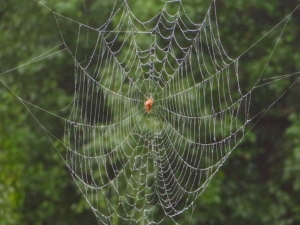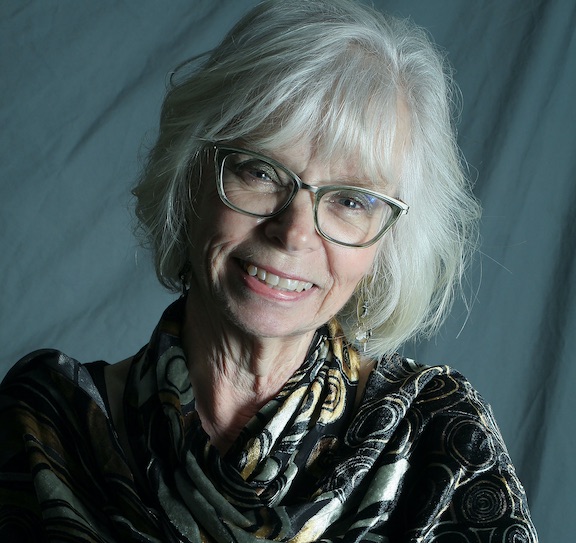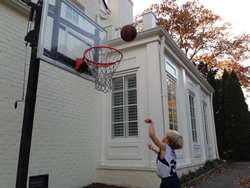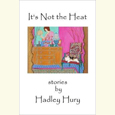Visible Signs
I’m looking for whatever support comes along, earthly and otherworldly
One morning last summer, surveying my backyard through the glass door, I happened to look up, above the hydrangeas, above the steepled Japanese maple. Remnants of Hurricane Ida had brought needed rainfall to thirsty August, even the hardiest in my gardens splayed and panting. A glitter caught my eye, a wet-hung web, an orb weaver, whose kettle bottom spins the dark hours into wheel-like spokes for her prey. It seemed suspended in nothingness, rippling in the wind and patter. Where were the anchor threads? The powerline was at least 4 feet away, the roof more than 6 feet. A creation so tenuous, yet so steely, daring the weather to take it, bring it down.

Her foundation scaled the top, networked like a rope bridge, the lower strands trailing. I saw no stabilimentum, dense silk zig-zagging from the center, which to insects blazes like a giant neon “Eat Here” signal. I saw no connecting stability at all, except within the web itself. In the middle, a large hole woven all around, right where Charlotte would’ve cast her messages — dare I say a portal inviting me to look and look again at the presence luminous within the absence? There for me to turn over in mind and heart, to enter impossibility, to see and be anew?
I’ve seen the handiwork of a barn spider, also an orb weaver, in the rafters of my gazebo. Once while cleaning fur from my neighbor’s cat off the chair cushions, I noticed a bulge in one of the Tibetan prayer flags strung across the lintel. I unwrapped it, and down spun the spider on a single thread, both of us equally startled. I had disturbed her daytime napping place and won’t do that again! I prefer peaceful coexistence with the creatures of my gardens and take comfort in her cocooning herself as a form of prayer, there in the outer refuge I’ve created of shade, wicker, and linen. I like to think of all gardening as prayer — bowed to work’s altar, a purposeful effort to shape and be shaped, order and reorder, cleansed, oddly enough, by sweat, grime, toil. Certainly, I’m often on my knees, grateful for the steadying ground and its offerings.
I’d like to think the weaver traveled all the way from the side yard for my sake this morning, drawn by forces more powerful than a good lunch — to cast another kind of wordfulness, an open-doored mystery to wonder, perhaps to be deciphered, perhaps merely to show off its symmetry, an overnight sensation hanging just out of reach.
Over the last four years, I’ve lost my three parents (including my stepmother) and a former spouse. As the Frost poem goes, I’m one acquainted with the night, what pricks the veil of the otherworld and slips through in revealing ways, what speaks in synchronous objects and happenings, sharing a glimpse of cosmic guidance. This web was especially telling, and I laughed to remember the old commercial for Playtex bras: No visible means of support.
These days I’m looking harder for signs, for whatever support comes along, earthly and otherworldly. I’m a believer in synchronicity: one sighting begets another — the more you see, the more you get — like these spiraled pearls outside my door just as summer ends, on the cusp of bittersweetness when losses cut deeper in autumn, bleed into the brilliant dying back.

I watched the web on and off all day, intrigued as the winged catch she labored and hoped for. A mini-constellation quilted as if for me alone to find and see past sight and knowing, past the past itself and the groundedness we all seek in torrents of storm, grief, and uncertainty. Buddhist teaching, or dharma, says that to relax into being and to be fully present, we must become comfortable with the uncomfortable in our lives, we must settle into it like a shouldered shawl. Any other way only brings more suffering. At first, I thought the webbed vision was a lesson in nonattachment, another important tenet in the dharma, but the more I stared, the more meaning wheeled out. By dinnertime, it was bedraggled, its former glory dimmed by light and wind — but the grace remained intact.
Suspended as we all are in perceived nothingness, so often we teeter like a pyramid of Flying Wallendas without a safety net, without their daredevilry, wondering how we got there and how on earth to get down. How easy to forget that, although visible signs may be scarce, we are held by unseen strands and are exactly where we’re meant to be. Dewy and anchored in the not knowing of mid-air. Always looking up.

Copyright © 2022 by Linda Parsons. All rights reserved. Poet, playwright, essayist, and editor, Linda Parsons is the poetry editor for Madville Publishing and the copy editor for Chapter 16. Widely published, her fifth poetry collection is Candescent (Iris Press, 2019). Five of her plays have been produced by Flying Anvil Theatre in Knoxville. She is an eighth-generation Tennessean.


